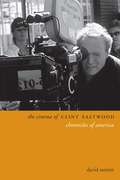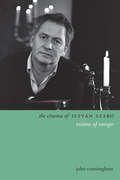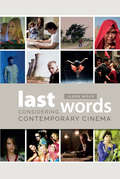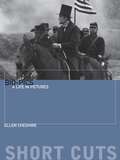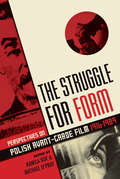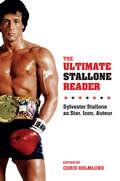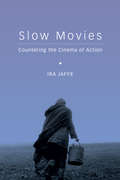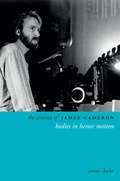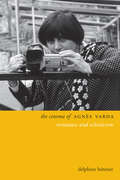- Table View
- List View
The Cinema of Clint Eastwood
by David SterrittHe became a movie star playing The Man With No Name, and today his name is known around the world. Measured by longevity, productivity, and profits, Clint Eastwood is the most successful actor-director-producer in American film history. This book examines the major elements of his career, focusing primarily on his work as a director but also exploring the evolution of his acting style, his long association with screen violence, his interest in jazz, and the political views - sometimes hotly controversial - reflected in his films and public statements. Especially fascinating is the pivotal question that divides critics and moviegoers to this day: is Eastwood a capable director with a photogenic face, a modest acting talent, and a flair for marketing his image? Or is he a true cinematic auteur with a distinctive vision of America's history, traditions, and values? From A Fistful of Dollars and Dirty Harry to Million Dollar Baby and beyond, The Cinema of Clint Eastwood takes a close-up look at one of the screen's most influential and charismatic stars.
The Cinema of Clint Eastwood: Chronicles of America (Directors' Cuts)
by David SterrittHe became a movie star playing The Man With No Name, and today his name is known around the world. Measured by longevity, productivity, and profits, Clint Eastwood is the most successful actor-director-producer in American film history. This book examines the major elements of his career, focusing primarily on his work as a director but also exploring the evolution of his acting style, his long association with screen violence, his interest in jazz, and the political views – sometimes hotly controversial – reflected in his films and public statements. Especially fascinating is the pivotal question that divides critics and moviegoers to this day: is Eastwood a capable director with a photogenic face, a modest acting talent, and a flair for marketing his image? Or is he a true cinematic auteur with a distinctive vision of America's history, traditions, and values? From A Fistful of Dollars and Dirty Harry to Million Dollar Baby and beyond, The Cinema of Clint Eastwood takes a close-up look at one of the screen's most influential and charismatic stars.
The Cinema of István Szabó: visions of Europe
by John CunninghamThe first English-language study of all Szabó's feature films and uses material from interviews with him and his collaborators
The Cinema of István Szábo
by John CunninghamIstván Szabó is one of Hungary's most celebrated and best-known film directors, and the only Hungarian to have won an Academy Award for Best Foreign Language Film, for Mephisto (1981). In a career spanning over five decades Szabó has relentlessly examined the place of the individual in European history, particularly those caught up in the turbulent events of Central Europe and his own native Hungary. His protagonists struggle to find a place for themselves, some meaning in their lives, security and a sense of being, against a background of two world wars (Colonel Redl, Confidence), the Holocaust (Sunshine), the Hungarian Uprising and the Cold War (Father, 25 Fireman's Street, Taking Sides). This is the first English-language study of all his feature films and uses material from interviews with Szabó and his collaborators. Also included are chapters on his formative years, including his time at the famous Budapest Film Academy and the relationship of the state to the film industry in Hungary.
The Cinema of István Szabó: Visions of Europe (Directors' Cuts)
by John CunninghamIstván Szabó is one of Hungary's most celebrated and best-known film directors, and the first Hungarian to have won an Academy Award for Best Foreign Language Film, for Mephisto (1981). In a career spanning over five decades Szabó has relentlessly examined the place of the individual in European history, particularly those caught up in the turbulent events of Central Europe and his own native Hungary. His protagonists struggle to find a place for themselves, some meaning in their lives, security and a sense of being, against a background of two world wars (Colonel Redl, Confidence), the Holocaust (Sunshine), the Hungarian Uprising, and the Cold War (Father, 25 Fireman's Street, Taking Sides). This is the first English-language study of all his feature films and uses material from interviews with Szabó and his collaborators. Also included are chapters on his formative years, including his time at the famous Budapest Film Academy and the relationship of the state to the film industry in Hungary.
Last Words: Considering Contemporary Cinema
by Jason WoodLast Words features extensive interviews with contemporary directors and overviews of the directors' work
Last Words
by Jason WoodLast Words features extensive interviews with Christopher Nolan, Harmony Korine, Charlie Kaufmann, Nicolas Winding Refn, Wim Wenders, Michael Winterbottom, Christian Petzhold, and many others. Each interview is preceded by an overview of the director's work, and the volume's authoritative introductory essay explores the value of these directors and why they are rarely given an appropriate platform to discuss their craft.
Last Words: Considering Contemporary Cinema
by Jason WoodLast Words features extensive interviews with Christopher Nolan, Harmony Korine, Charlie Kaufmann, Nicolas Winding Refn, Wim Wenders, Michael Winterbottom, Christian Petzhold, and many others. Each interview is preceded by an overview of the director's work, and the volume's authoritative introductory essay explores the value of these directors and why they are rarely given an appropriate platform to discuss their craft.
Bio-pics: A Life in Pictures
by Ellen CheshireThrough a carefully selected range of thematically linked bio-pics, explores key issues surrounding their resurgence, structure, production, subject representation or misrepresentation, and critical response
Bio-pics
by Ellen CheshireThrough a carefully selected range of thematically linked bio-pics, explores key issues surrounding their resurgence, structure, production, subject representation or misrepresentation, and critical response
Bio-pics: A Life in Pictures (Short Cuts)
by Ellen CheshireBio-pics: A Life in Pictures offers a series of case studies which throw light on this most unique of genres. Is the bio-pic a genre in its own right? Or are such films merely footnotes in other more traditional genres such as the western or costume drama, depending on the historical figure under scrutiny. Unlike other genre forms bio-pics seemingly share no familiar iconography, codes or conventions. They can be set anywhere and at any time. What links them is quite simply that the films depict the life of an 'important' person. Through a carefully selected range of thematically linked (English-language) bio-pics released since 1990 this book explores key issues surrounding their resurgence, narrative structure, production, subject representation or misrepresentation, and critical response. The films under discussion are grouped around a profession (writers, singers, politicians, sportsmen, criminals, artists) allowing for comparisons to be drawn in approaches to similar subject matter.
The Gangster Film: Fatal Success in American Cinema
by Ron WilsonExamines the gangster film in its historical context with an emphasis on the ways the image of the gangster has adapted and changed
The Gangster Film
by Ron WilsonExamines the gangster film in its historical context with an emphasis on the ways the image of the gangster has adapted and changed
The Gangster Film: Fatal Success in American Cinema (Short Cuts)
by Ron WilsonThis volume examines the gangster film in its historical context with an emphasis on the ways the image of the gangster has adapted and changed as a result of socio-cultural circumstances. From its origins in Progressive-era reforms to its use as an indictment of corporate greed, the gangster film has often provided a template for critiquing American ideas and values concerning individualism, success, and business acumen. The gangster genre has also been useful in critically examining race and ethnicity in American culture in terms of "otherness." Films studied include Musketeers of Pig Alley (1912), The Racket (1928), The Captive City (1952), The Godfather, Part Two (1974), Goodfellas (1990), and Killing Them Softly (2012).
The Struggle for Form
by Kamila KucThis is the first comprehensive English-language account of the Polish avant-garde film, from its beginnings in the early decades of the last century to the collapse of communism in 1989. Taking a broad understanding of avant-garde film, this collection includes writings on the pioneering work of the internationally-acclaimed Franciszka and Stefan Themerson; the Polish Futurists' (Jalu Kurek, Anatol Stern) engagement with film; the Thaw and animation (Jan Lenica and Walerian Borowczyk, Andrzej Pawlowski, Zbigniew Rybczynski); documentary (Natalia Brzozowska, Kazimierz Karabasz, Wojciech Wiszniewski), Polish émigré filmmakers (Roman Polanski, Jerzy Skolimowski, Andrzej Zulawski) as well as essays and documentation on the highly influential Film Form Workshop (Józef Robakowski, Ryszard Wasko, Wojciech Bruszewski). Including a mix of historical writings from early film magazines with commissioned essays, this book constitutes an important source on the rich, complex and diverse history of the Polish film avant-garde, which is presented from the perspective of both British (A. L. Rees, Jonathan Owen, Michael O'Pray) and Polish (Marcin Gizycki, Ryszard Kluszczynski, Kamila Kuc) authorities on the subject. This book is thus an indispensable introduction to the theories and practices of critically important avant-garde artists and filmmakers.
The Struggle for Form
by Kamila KucThis is the first comprehensive English-language account of the Polish avant-garde film, from its beginnings in the early decades of the last century to the collapse of communism in 1989. Taking a broad understanding of avant-garde film, this collection includes writings on the pioneering work of the internationally-acclaimed Franciszka and Stefan Themerson; the Polish Futurists' (Jalu Kurek, Anatol Stern) engagement with film; the Thaw and animation (Jan Lenica and Walerian Borowczyk, Andrzej Pawlowski, Zbigniew Rybczynski); documentary (Natalia Brzozowska, Kazimierz Karabasz, Wojciech Wiszniewski), Polish émigré filmmakers (Roman Polanski, Jerzy Skolimowski, Andrzej Zulawski) as well as essays and documentation on the highly influential Film Form Workshop (Józef Robakowski, Ryszard Wasko, Wojciech Bruszewski). Including a mix of historical writings from early film magazines with commissioned essays, this book constitutes an important source on the rich, complex and diverse history of the Polish film avant-garde, which is presented from the perspective of both British (A. L. Rees, Jonathan Owen, Michael O'Pray) and Polish (Marcin Gizycki, Ryszard Kluszczynski, Kamila Kuc) authorities on the subject. This book is thus an indispensable introduction to the theories and practices of critically important avant-garde artists and filmmakers.
The Struggle for Form: Perspectives on Polish Avant-Garde Film, 1916–1989
by Michael Eds. Kuc Kamila O’PrayThis is the first comprehensive English-language account of the Polish avant-garde film, from its beginnings in the early decades of the last century to the collapse of communism in 1989. Taking a broad understanding of avant-garde film, this collection includes writings on the pioneering work of the internationally-acclaimed Franciszka and Stefan Themerson; the Polish Futurists' (Jalu Kurek, Anatol Stern) engagement with film; the Thaw and animation (Jan Lenica and Walerian Borowczyk, Andrzej Pawlowski, Zbigniew Rybczynski); documentary (Natalia Brzozowska, Kazimierz Karabasz, Wojciech Wiszniewski), Polish émigré filmmakers (Roman Polanski, Jerzy Skolimowski, Andrzej Zulawski) as well as essays and documentation on the highly influential Film Form Workshop (Józef Robakowski, Ryszard Wasko, Wojciech Bruszewski). Including a mix of historical writings from early film magazines with commissioned essays, this book constitutes an important source on the rich, complex and diverse history of the Polish film avant-garde, which is presented from the perspective of both British (A. L. Rees, Jonathan Owen, Michael O'Pray) and Polish (Marcin Gizycki, Ryszard Kluszczynski, Kamila Kuc) authorities on the subject. This book is thus an indispensable introduction to the theories and practices of critically important avant-garde artists and filmmakers.
The Ultimate Stallone Reader
by Chris HolmlundSylvester Stallone has been a defining part of American film for nearly four decades. He has made an impact on world entertainment in a surprisingly diverse range of capacities -- as actor, writer, producer, and director -- all while maintaining a monolithic presence. With The Ultimate Stallone Reader, this icon finally receives concerted academic attention. Eleven original essays by internationally-known scholars examine Stallone's contributions to mainstream cinema, independent film, and television. This volume also offers innovative approaches to star, gender, and celebrity studies, performance analysis, genre criticism, industry and reception inquiry, and the question of what it means to be an auteur. Ultimately, The Ultimate Stallone Reader investigates the place that Sylvester Stallone occupies within an industry and a culture that have both undergone much evolution, and how his work has reflected and even driven these changes.
The Ultimate Stallone Reader: Sylvester Stallone as Star, Icon, Auteur
by Ed. Chris HolmlundSylvester Stallone has been a defining part of American film for nearly four decades. He has made an impact on world entertainment in a surprisingly diverse range of capacities – as actor, writer, producer, and director – all while maintaining a monolithic presence. With The Ultimate Stallone Reader, this icon finally receives concerted academic attention. Eleven original essays by internationally-known scholars examine Stallone's contributions to mainstream cinema, independent film, and television. This volume also offers innovative approaches to star, gender, and celebrity studies, performance analysis, genre criticism, industry and reception inquiry, and the question of what it means to be an auteur. Ultimately, The Ultimate Stallone Reader investigates the place that Sylvester Stallone occupies within an industry and a culture that have both undergone much evolution, and how his work has reflected and even driven these changes.
Slow Movies
by Ira Jaffe"In all film there is the desire to capture the motion of life, to refuse immobility," Agnes Varda has noted. But to capture the reality of human experience, cinema must fasten on stillness and inaction as much as motion. Slow Movies investigates movies by acclaimed international directors who in the past three decades have challenged mainstream cinema's reliance on motion and action. More than other realist art cinema, slow movies by Lisandro Alonso, Nuri Bilge Ceylan, Pedro Costa, Jia Zhang-ke, Abbas Kiarostami, Cristian Mungiu, Alexander Sokurov, Bela Tarr, Gus Van Sant and others radically adhere to space-times in which emotion is repressed along with motion; editing and dialogue yield to stasis and contemplation; action surrenders to emptiness if not death.
Slow Movies: Countering the Cinema of Action
by Ira Jaffe"In all film there is the desire to capture the motion of life, to refuse immobility," Agnes Varda has noted. But to capture the reality of human experience, cinema must fasten on stillness and inaction as much as motion. Slow Movies investigates movies by acclaimed international directors who in the past three decades have challenged mainstream cinema's reliance on motion and action. More than other realist art cinema, slow movies by Lisandro Alonso, Nuri Bilge Ceylan, Pedro Costa, Jia Zhang-ke, Abbas Kiarostami, Cristian Mungiu, Alexander Sokurov, Bela Tarr, Gus Van Sant and others radically adhere to space-times in which emotion is repressed along with motion; editing and dialogue yield to stasis and contemplation; action surrenders to emptiness if not death.
The Cinema of James Cameron
by James ClarkeThis timely volume explores the massively popular cinema of writer-director James Cameron. It couches Cameron's films within the evolving generic traditions of science fiction, melodrama, and the cinema of spectacle. The book also considers Cameron's engagement with the aesthetic of visual effects and the 'now' technology of performance-capture which is arguably moving a certain kind of event-movie cinema from photography to something more akin to painting. This book is explicit in presenting Cameron as an authentic auteur, and each chapter is dedicated to a single film in his body of work. Space is also given to discussion of Strange Days as well as his documentary works.
The Cinema of James Cameron
by James ClarkeThis timely volume explores the massively popular cinema of writer-director James Cameron. It couches Cameron's films within the evolving generic traditions of science fiction, melodrama, and the cinema of spectacle. The book also considers Cameron's engagement with the aesthetic of visual effects and the 'now' technology of performance-capture which is arguably moving a certain kind of event-movie cinema from photography to something more akin to painting. This book is explicit in presenting Cameron as an authentic auteur, and each chapter is dedicated to a single film in his body of work. Space is also given to discussion of Strange Days as well as his documentary works.
The Cinema of James Cameron: Bodies in Heroic Motion (Directors' Cuts)
by James ClarkeThis timely volume explores the massively popular cinema of writer-director James Cameron. It couches Cameron's films within the evolving generic traditions of science fiction, melodrama, and the cinema of spectacle. The book also considers Cameron's engagement with the aesthetic of visual effects and the 'now' technology of performance-capture which is arguably moving a certain kind of event-movie cinema from photography to something more akin to painting. This book is explicit in presenting Cameron as an authentic auteur, and each chapter is dedicated to a single film in his body of work, from The Terminator to Avatar. Space is also given to discussion of Strange Days as well as his short films and documentary works.
The Cinema of Agnès Varda
by Delphine BenezetAgnès Varda, a pioneer of the French New Wave, has been making radical films for over half a century. Many of these are considered by scholars, filmmakers, and audiences alike, as audacious, seminal, and unforgettable. This volme considers her production as a whole, revisiting overlooked films like Mur, Murs/Documenteur (1980--81), and connecting her cinema to recent installation work. This study demonstrates how Varda has resisted norms of representation and diktats of production. It also shows how she has elaborated a personal repertoire of images, characters, and settings, which all provide insight on their cultural and political contexts. The book thus offers new readings of this director's multifaceted rêveries, arguing that her work should be seen as an aesthetically influential and ethically-driven production where cinema is both a political and collaborative practice, and a synesthetic art form.
